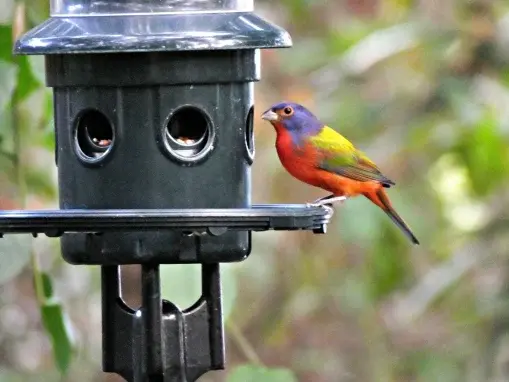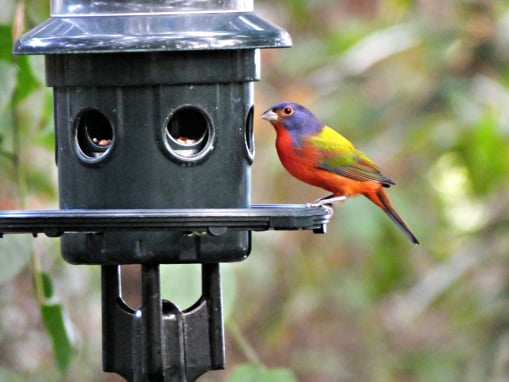
Posted July 31st 2020
Which Birds Are Most Susceptible to Building Collisions?

Posted July 31st 2020
Which Birds Are Most Susceptible to Building Collisions?
There are many reasons why birds collide with windows. Maybe you’re already familiar with why windows are dangerous for birds and had a chance to read more about window collisions in last month’s blog post! But, if you need a refresher, American Bird Conservancy (ABC) collision experts, Christine Sheppard and Bryan Lenz, state that birds generally perceive reflections in glass as part of their environment, which means they view glass as an escape from predators, or a possible source of food, rather than a solid object. Although we can attribute seasonal spikes in bird-building collisions to the return of migratory birds, there are many local species that are at-risk year-round. And, some are more vulnerable than others.
These at-risk species vary regionally and may differ from one state or country to the next. However, no matter which species of bird you aim to protect, citizens, businesses and corporations can make their buildings bird-friendly to safe-guard vulnerable species. When you try to protect one species from extinction, you communicate the value of birds in our ecosystem and can raise awareness to protect them, which supports conservation on both local and national levels. If you’re eager to get started, Feather Friendly® makes a DIY tape kit, which is designed specifically for homeowners who want to protect birds from windows collisions. Our bird deterrent makers are easy to install and will keep birds safe.
Bird Species and Window Collisions
According to a study on bird-building collisions and species mortality by Loss et al. (2014), published in The Condor, some bird species are more likely to collide with any building, regardless of its location or size, and are at the greatest risk of extinction or population decline. Most experts agree that it’s difficult to narrow down the bird species that are most susceptible and that they vary depending on state, province, or region. In their 2014 study, Loss et al. named the following species as highly susceptible to building collisions:
- Ruby-throated Hummingbird
- Brown Creeper
- Ovenbird
- Yellowbellied Sapsucker
- Gray Catbird
- Black-and-white Warbler
The Golden-winged Warbler, Canada Warbler, Painted Bunting and Kentucky Warbler are also mentioned as some of the species that are vulnerable to collisions with high- and low-rise buildings in rural and urban areas.
However, scientists and researchers are careful to note that bird—building collision statistics may only indicate the abundance of a specific population without representing its overall susceptibility. A study conducted by Wittig et al. (2017) in Avian Conservation and Ecology reminds us that migratory patterns and behaviours vary across North America, and between different bird populations. When compared to locally abundant species, Wittig et al. observed that “migratory species were disproportionally vulnerable to collisions, regardless of their abundance.” So, we can conclude that, over time, it’s possible that local birds become accustomed to certain buildings, windows and environmental obstacles that migratory species may not be used to.
Why Do Birds Collide With Windows Even When They’re Not Migrating?
As we mentioned in a previous blog post, birds don’t have the ability to perceive glass like we do. As a result, window collisions occur year-round during the day and at night. All About Birds suggests that reflective surfaces are responsible for most daytime collisions where birds hit the window because they see plants inside the window, see their environment reflected on the window, or mistake their reflection for another bird, which causes them to collide with the window. Birds can also hit windows accidentally, sometimes caused by a poorly placed bird feeder, or exhaustion after a long flight. At night, many birds are “lured to their deaths” when they become lost or disoriented by city lights.
Migrating birds are, arguably, more susceptible to window collisions, which is due in part to their changing environment. In between migratory seasons, local and migratory populations will begin to make nests, find mates and raise young. Their competition for food and other resources doesn’t keep them safe from window collisions: new buildings, less food and shrinking habitats can push birds to seek shelter and nutrition elsewhere, which can lead them into unfamiliar and dangerous territory.
How You Can Prevent Window Collisions Using Bird Deterrent Markers
Based on their research, Loss et al concluded that, some species, like “ducks and geese, swallows, herons, upland game birds, and blackbirds, meadowlarks, and orioles,” are the least likely species to collide with windows. But, what does this mean for the rest of the bird populations, and the lesser known species, that exist? How can we protect them? The simplest and most effective way to prevent window collisions, and the vulnerable species that are affected by them, is to outfit your windows with bird deterrent window markers, or participate in a “Lights Out” program in your neighbourhood.
Exterior window markers give birds a chance to “see” the windows before they collide with them. Feather Friendly® window markers are easy to install and are long-lasting, so you can set them and forget them! Despite reflections not being a big concern at night, scientists, conservationists and citizens have come to recognize that lights somehow disrupt a bird’s natural navigational instincts and can cause them to collide with windows. Chicago’s “Lights Out” initiative is just one example of how a city has come together to encourage businesses and residents to actively turn their lights out to make the skies safer for birds.
Let’s Keep Making Skies Safer for Birds!
Prevent window collisions by installing Feather Friendly® bird deterrent markers on your home or office windows today! But don’t stop there: your efforts toward protecting vulnerable bird species can go beyond what you do at home, so connect with friends, family, co-workers and councillors to demand effective window collision prevention in your city. You can help educate others about the importance of birds in our society and how to protect their population.
Partners
We are honoured to form partnerships with organizations who demonstrate
an ongoing commitment to bird conservation.



